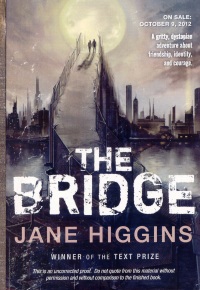| ________________
CM . . .
. Volume XVIIII Number 2. . . .September 14, 2012
excerpt:
A few days after being denied entrance into the ISIS (the Internal Security and Intelligence Services), Nik Stais is dealt another devastating blow: his Cityside school is bombed and, in the aftermath of that destruction and disorder, Sol, the younger brother of his life-long friend and classmate Fyffe, is captured by hostiles. Refusing to let this stand, Nik and Fyffe follow the perpetrators across the bridge and into the unknown territory of the Southside in order to save a beloved friend and brother from unspeakable horrors at the hands of bitter enemies. What follows is truly an engrossing and compelling story. Nik and Fyffe are forced to navigate an alien urban landscape populated by hostiles. Using wit and ingenuity, and a lot of luck, they manage to align themselves alongside high-ranking members of the hostiles in the hope that they can collect information about Sol’s whereabouts. Living with the enemy, however, they discover that all that they knew, and all that they were taught to believe about their southern counterparts, deserves questioning. It is also from this realization that Nik is forced to reexamine his own past and identity, an examination which brings him to question not only his loyalty in the war, but also his understanding of the current state of affairs and the wider world around him. For Nik especially, who to trust and what is the truth become increasingly difficult to comprehend as secret agendas and alliances are uncovered and hatched by both friend and foe alike. Higgins’ depiction of a world gone mad on war and drunk on power and fear is on par with the best that dystopian literature has to offer. In many respects, however, The Bridge surpasses its contemporaries as it delves into areas rarely explored so convincingly by others in the genre. Issues of race, class, and poverty, as well as religion, power, and politics, are handled with great skill and care, leading readers ultimately to surmise that fanaticism, that which does not tolerate the rights and needs of minority populations—the poor, the disenfranchised, and foreigners—is inherently a misguided and problematic endeavor. By book’s end, readers will have also examined tangible pathways to peace and conflict resolution. One conversation, in particular, had between Nik and Suzannah (a Southside prisoner of war), will stand out. In it, the Moldam Bridge, which stands at the center of the war, is used metaphorically to explain the means by which divisions and differences can be overcome and ultimately a lasting peace between the Cityside and the Southside can be brokered. This stands in contrast to previous descriptions of the bridge as an obstacle or instrument of separation and segregation. And while this is a seminal event in the book, it does not come about as didactic; readers will appreciate it as a poignant argument on how, through sincere negotiations, even the most embattle foes (or friends) can actively work towards mutual harmony. The book is narrated in the first-person through the main character of Nik; it comes fast, clean, and simple, yet wonderfully descriptive. At times, however, Nik’s voice does seem limited, unable to keep up with the large cast of characters and their individual insights and motivations. Likewise, filled with numerous plot twists and action sequences (which hit hard), The Bridge is paced as fast they come despite being just shy of the 350 page mark. While parallels can be drawn with the “Hunger Games” trilogy, fans of Suzanne Collins’ popular series may not necessarily be admirers of The Bridge as the tone and themes covered in the latter book are perhaps more closely aligned to the sensibilities of a slightly older audience of young adult readers. For example, certain younger readers may look unfavorably on the fact that Higgins did not incorporate any meaningful elements of romantic love, despite the potential to explore such a story line. With that said, however, avid enthusiasts of dystopian literature, both male and female, should not pass on The Bridge, nor should librarians shy away from recommending this title to younger readers due to its dark and complex nature. Praise should also be extended to the wonderfully rendered cover art designed by Sebastian Ciaffaglione. With remarkable simplicity and subtlety, it captures brilliantly both the desperation and hope embodied within The Bridge. Highly Recommended. Andrew Laudicina, a recent MLIS graduate from the University of Western Ontario in London, ON, currently resides in Windsor, ON.
To comment
on this title or this review, send mail to cm@umanitoba.ca.
Copyright © the Manitoba Library Association. Reproduction for personal
use is permitted only if this copyright notice is maintained. Any
other reproduction is prohibited without permission.
NEXT REVIEW |
TABLE OF CONTENTS FOR THIS ISSUE
- September 14, 2012.
AUTHORS |
TITLES |
MEDIA REVIEWS |
PROFILES |
BACK ISSUES |
SEARCH |
CMARCHIVE |
HOME |
